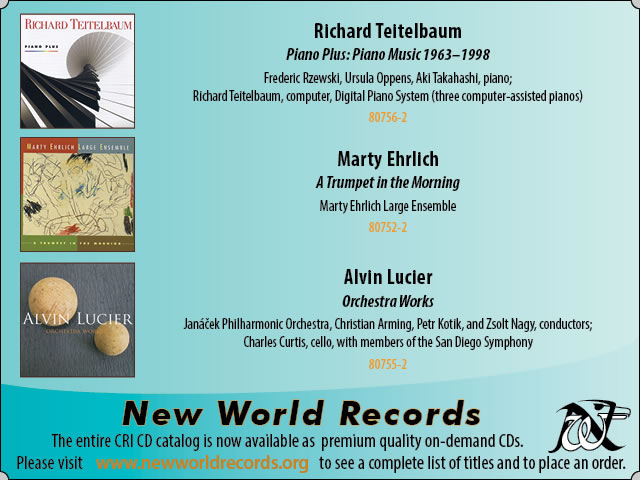Moment's Notice
Reviews of Recent Recordings
(continued
Harris Eisenstadt
Golden State
Songlines SGL 1602-2
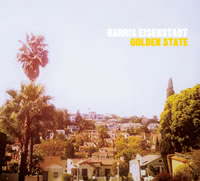 Canadian-born drummer Harris Eisenstadt is one of the most prolific musicians of his generation. An in-demand sideman, adept improviser and formidable composer, Eisenstadt has also proven to be a stalwart bandleader, of both the collaboratively led Convergence Quartet and September Trio, as well as his own flagship ensemble, Canada Day. Golden State is his newest and most unusual endeavor; the atypical quartet’s self-titled debut is Eisenstadt’s 15th recording as a leader since 2001 and a salient example of his affinity for writing improvisation-based pieces designed to be performed by orchestral instruments, an abiding interest first revealed on Fight or Flight (Newsonic, 2002).
Canadian-born drummer Harris Eisenstadt is one of the most prolific musicians of his generation. An in-demand sideman, adept improviser and formidable composer, Eisenstadt has also proven to be a stalwart bandleader, of both the collaboratively led Convergence Quartet and September Trio, as well as his own flagship ensemble, Canada Day. Golden State is his newest and most unusual endeavor; the atypical quartet’s self-titled debut is Eisenstadt’s 15th recording as a leader since 2001 and a salient example of his affinity for writing improvisation-based pieces designed to be performed by orchestral instruments, an abiding interest first revealed on Fight or Flight (Newsonic, 2002).
The inspiration behind Golden State has roots in Eisenstadt’s 2012 residence at CalArts, where he and wife Sara Schoenbeck frequently worked with Chicago émigré Nicole Mitchell and West Coast veteran Mark Dresser. Eisenstadt’s decision to pair Schoenbeck’s earthy bassoon with Mitchell’s diaphanous flute yields a colorful instrumental palette brimming with variegated hues, a synesthetic detail further enriched by Dresser’s sinewy arco and reverberating pizzicato.
Subtly influenced by the open-ended forms embraced by first generation AACM composers like Anthony Braxton, Wadada Leo Smith and Henry Threadgill, Eisenstadt’s intricate writing for the quartet incorporates myriad devices, including odd-metered pulses, polytonal harmonies and contrapuntal melodies. Spacious, but dominated by off-kilter rhythms and thorny contours, these urbane chamber works occasionally evoke Braxton’s influence – unsurprisingly, since all but the leader have worked with him at one time or another. Nonetheless, Eisenstadt’s approach is far more groove-oriented; he maintains a compelling sense of forward momentum through cyclical pattern variation, avoiding standardized time signatures altogether. Dresser’s oblique bass figures subsequently interlock with these irregular but accessible ostinatos, spurring the winds on in turn.
The ensemble executes these labyrinthine compositions with breathtaking dexterity, whether negotiating the abstract funk that underpins “What Is a Straw Horse, Anyways?” or the fragmented swing of “Especially Preposterous Assertions.” Revealing an all-encompassing aesthetic, the wistful ballad “Sandy” showcases the unit’s penchant for unabashed lyricism, as Schoenbeck, Mitchell and Dresser ply bittersweet motifs from a pastoral theme. Conveying a more forceful approach, engaging tunes like “Dogmatic in Any Case” and “Unless All the Evidence is In” offer striking demonstrations of the members’ quicksilver virtuosity and masterful integration of extended techniques, including ghostly woodwind overtones, rancorous double-reed multiphonics, stratified string harmonics and kaleidoscopic percussion interjections.
The foursome’s rapport borders on the clairvoyant, with Eisenstadt and Dresser’s modulating interplay providing an elastic foundation for the frontline’s probing extrapolations. Schoenbeck’s rigorously defined contours and Mitchell’s unfettered flights alternate between individual ruminations and dual improvisations; the latter often executed in loose harmony or tight counterpoint. Greater than the sum of its parts, Golden State is a singularly captivating effort from Eisenstadt and company, verifying the neo-classical post-war experiments of the Third Stream movement and the pan-stylistic hybrids of the loft jazz era as enduring sources of inspiration for creative improvising musicians.
–Troy Collins
Amir ElSaffar
Alchemy
Pi Recordings PI51
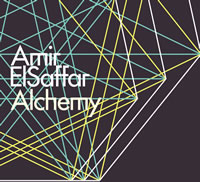 In 2002, while still in his mid-20s, conservatory trained Iraqi-American jazz trumpeter Amir ElSaffar embarked on an investigation of his Iraqi heritage, studying maqam and other forms of classical Arabic music abroad with expatriate musicians in Baghdad and London. Inspired by his travels, he formed the multi-ethnic ensemble Two Rivers, whose self-titled Pi Recordings debut premiered in 2007; a sophomore effort, Inana, followed in 2011. A year earlier ElSaffar collaborated with Iranian-American tenor saxophonist Hafez Modirzadeh on Radif Suite, an unprecedented synthesis of Iraqi maqam and Persian dastgha inspired by Ornette Coleman’s innovative piano-less quartets.
In 2002, while still in his mid-20s, conservatory trained Iraqi-American jazz trumpeter Amir ElSaffar embarked on an investigation of his Iraqi heritage, studying maqam and other forms of classical Arabic music abroad with expatriate musicians in Baghdad and London. Inspired by his travels, he formed the multi-ethnic ensemble Two Rivers, whose self-titled Pi Recordings debut premiered in 2007; a sophomore effort, Inana, followed in 2011. A year earlier ElSaffar collaborated with Iranian-American tenor saxophonist Hafez Modirzadeh on Radif Suite, an unprecedented synthesis of Iraqi maqam and Persian dastgha inspired by Ornette Coleman’s innovative piano-less quartets.
Augmented by the distinctive Eastern tonalities of buzuq, oud and santoor, Two Rivers’ eclectic configuration provided the aforementioned releases a decidedly Eurasian palette, imbuing ElSaffar’s sophisticated jazz fusions with the ceremonial gravitas of maqam. Joined by tenor saxophonist Ole Mathisen, pianist John Escreet, bassist Francois Moutin and drummer Dan Weiss, Alchemy is ElSaffar’s first album to eschew exotic instrumentation in favor of a classic jazz quintet format.
Breaking free of Western hegemony, ElSaffar and company use extended techniques to play microtones on standard instruments, seamlessly incorporating the un-tempered scales of Arabic music into advanced post-bop structures. Conjuring memories of jazz’s recent past, many of these engaging numbers employ melodic motifs and swinging rhythms that evoke the punchy hard-bop and adventurous modal jazz of the late 1960s. But recognizable forms are only one element in ElSaffar’s chimerical concept of cross-cultural innovation; familiar riffs and chord changes are superimposed with microtonal modes and unusual time signatures, yielding a phantasmagoric mosaic of sound.
This otherworldly effect is the result of meticulous juxtapositions. The narrow intervals between the scales of most Arabic music include notes that fall “in-between” the evenly spaced pitches of their Western counterparts; subtle chromatic dissonances result when microtone capable horns play rich polytonal voicings in harmony with the fixed tonality of the piano, yielding a surreal harmonic tension previously unheard in ElSaffar’s music.
“Quartal” for example, regales with glassy discords when the frontline plays quarter tones against Escreet’s equal tempered filigrees. ElSaffar uses alternate fingerings and embouchure control to extend his trumpet’s expressive range, eliciting sinuous refrains that complement the pneumatic precision of Mathisen’s blistering staccato runs; their unfettered expressionism is a constant throughout the date, a stirring aspect underscored by Escreet’s dazzling pianism and the rhythm section’s deft interplay.
Awash with kaleidoscopic detail, Escreet’s oblique cadences vacillate between extremes, whether providing dulcet understatement to the introspective “Balad” or fueling the angular swinger “Athar Kurd,” whose bracing rhythms highlight Mountin’s modulating bass work and Weiss’ quicksilver trap set interpolations. “Embubum – Ishtarum – Pitum,” the episodic conclusion to the Ishtarum Suite, is the set’s conceptual centerpiece, a rousing amalgamation of propulsive modern jazz and modal lyricism based on ancient Babylonian and Sumerian modes. Most of the album’s pieces are culled from either the Ishtarum Suite or Alchemy Suite, instilling a sense of stylistic cohesion to the proceedings.
Efforts to combine Eastern and Western musical tenets are hardly new – successfully establishing common aesthetic ground between disparate cultures is a challenge however. Recent innovations by creative improvising musicians of Asian-American heritage (Fred Ho, Vijay Iyer, Rudresh Mahanthappa, etc.) have helped set a new standard for such endeavors. Emblematic of this paradigm, Alchemy is a milestone session that builds upon ElSaffar’s previous work, mixing Arabic traditions and established jazz conventions into a singular hybrid that transcends his prior accomplishments, lending credence to its title.
–Troy Collins
Paul Flaherty + Steve Swell + C. Spencer Yeh + Weasel Walter
Dragonfly Breath
Not Two MW890-2
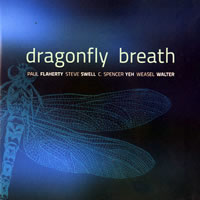 Percussionist Weasel Walter took New York by storm (would there be any other way?) when he relocated to Brooklyn from Oakland in 2010 to work with a cross-section of improvisers, composers, “jazz” and “rock” artists in both the fringes and the Cornelia Street out-mainstream. Though Walter’s extreme persona and dedication to blistering no wave and free music isn’t for everybody, the beyond-categorical openness with which he approaches art is a one-man microcosm for how diverse and interconnected the boroughs’ creative environments can be.
Percussionist Weasel Walter took New York by storm (would there be any other way?) when he relocated to Brooklyn from Oakland in 2010 to work with a cross-section of improvisers, composers, “jazz” and “rock” artists in both the fringes and the Cornelia Street out-mainstream. Though Walter’s extreme persona and dedication to blistering no wave and free music isn’t for everybody, the beyond-categorical openness with which he approaches art is a one-man microcosm for how diverse and interconnected the boroughs’ creative environments can be.
Dragonfly Breath was recorded mere months after Walter’s relocation, in the silo-like old Issue Project Room space in Gowanus, and joins the drummer with violinist C. Spencer Yeh (also using his voice quite liberally), alto/tenor saxophonist Paul Flaherty and trombonist Steve Swell on a program of three rousing group improvisations. Flaherty and Walter had recorded together previously in a quartet (End of the Trail, ugEXPLODE 32). Walter and Swell would go on to perform in an unsurprisingly garrulous trio with bassist Max Johnson, notably dusting up the Union Square Whole Foods in 2012.
A burnished and squirrelly harrier whose alto and tenor voices are garish and lusty, Flaherty should be in the pantheon of modern paint-peelers, though his music often has been boxed in with “noise” and “New Weird America” rather than jazz-derived improvisation. The same could easily be said of Yeh and Walter, both of whom get tagged with the “experimental/rock” moniker despite their total commitment to improvisation – Yeh’s violin sounding like an amplified, pedal-assisted Ramsey Ameen to Walter’s Shannon Jackson-inspired active thrust. Flaherty’s white-hot brays and obsessive curlicues, coupled with Swell’s brash and verbose slide, make for a tough horn partnership, but in actuality Dragonfly Breath might count among the deeper-listening dates in Walter’s discography. The drummer may have a penchant for “fire in a pet store” improvisation, and such pyrotechnics are plentiful, but the quartet’s potency lies within a spare ranginess absent any traditional rhythmic hookups.
Dragonfly Breath also exhibits an international approach, drawing equally from both post-Ayler American traditions and European free music. This is something that Walter has put forth repeatedly, and all four musicians came up in an era where ESP and FMP vinyl was equally available to anybody with dedicated ears. Limited to violin and horns, the music might seem top-heavy at first blush, though each player is quite aware of balancing tonal low and high ends. Dragonfly Breath is a blisteringly beyond-category document, and should hold an estimable place in the discographies of all four musicians for years to come.
–Clifford Allen
Flex Bent Braam
Lucebert
BBB 16
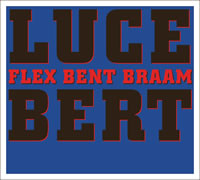 While leading his 13-piece Bik Bent Braam, Dutch pianist Michiel Braam always ran smaller bands on the side. The best of the units he’s assembled since BBB’s 2012 demise is the septet on Lucebert – although, the leader notes, the band will change from project to project. Pity: This lineup is close to ideal.
While leading his 13-piece Bik Bent Braam, Dutch pianist Michiel Braam always ran smaller bands on the side. The best of the units he’s assembled since BBB’s 2012 demise is the septet on Lucebert – although, the leader notes, the band will change from project to project. Pity: This lineup is close to ideal.
The horns include three BBB vets: trombone gadfly and ever-confident improviser Wolter Wierbos from ICP; inside/outside altoist Bart van der Putten, Bik Bent linchpin with a sizzling sound equally useful on blowtorch improvisations and rhapsodic ballads (“Get Out of Town”); and ex-Houdini’s trumpeter Angelo Verploegen, who’s got a gorgeous tone from top to bottom of the horn, gets from one to the other in a hurry, and is a great blender. Also Braam’s student discovery, German bari saxophonist Oleg Hollmann. He can skronk against the grain, but also has a little Serge Chaloff’s plush timbre, which can lend the music a ‘50s cool veneer. Hollmann shows both tendencies on a mash-up of “I May Be Wrong” and “So What.”
Lucebert (1924-1994) was a poet and “my kid could do that” CoBrA-school painter beloved in Holland, and the CD alternates pieces from two related programs. The odd numbered tracks are drawn from a list Lucebert made in the ‘50s, of jazz standards he particularly valued. The evens are Braam originals based on the poet’s “Japanese Epigrams” from the same decade. To my ears, the standards and originals go down better when they’re separated. Both programs are strong but don’t quite mesh.
On Mingus’ 6/8 “Better Git It in Your Soul,” Braam the arranger drops beats here and there, recalling an early piece by his countryman Guus Janssen that played a similar game with Bert Kaempfert’s “A Swingin’ Safari.” (The blowing goes into 5, a Brubeck montuno.) The tempo games on Monk’s “Let’s Cool One” recall Janssen too; the rhythm section seems to momentarily slide out from under the horns on the head. But then Braam always did honor his lowland elders; there’s a little Mengelbergian whimsy in his dubious harmonizations (“I May Be Wrong”) and creeping-mice solos (“Get Out of Town”).
On George Russell’s “Stratus Seekers,” the horns lay into the bop head, then dive into caterwauling free space, and then fall back into the form with a string of solos, the pianist sounding rather Russellesque behind. Braam’s originals likewise walk an inside/outside line, shifting from one foot to the other in the course of a performance. “Rijp” is a smeary romp on rhythm changes where Wolter plungers like Roswell Rudd. Horns softly coalesce on “Plek” and “Herfst,” bleeding together a la Monuments-era Available Jelly, the brass in particular melding sublimely. Stealthy “Herfst” (Autumn) is propelled by Tony Overwater’s chunky bass beat, and his stately arco is featured on “Spijt,” over courtly pulsing horns. And he hooks up well with the pianist.
The band’s weakest link is Joost Lijbaart, who lacks the assertive creativity of a Bennink or Jelly/Braam drummer Michael Vatcher, who’ll smash the vase just to watch everyone else scurry to clean it up. One wishes for more percussive direction on the open sections, where Lijbaart tends to wilt away. The rest of the band is too good to break up.
–Kevin Whitehead
Lafayette Gilchrist
The View From Here
www.lafayettegilchrist.net
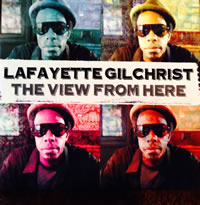 This is virtually a solo piano blues CD, although only one song relies on the standard 12-bar form. Gilchrist freely switches harmonic structures around, even occasionally digresses into ballad phrasing. Most of these 11 songs are built on urgent boogie lines and/or a striding left hand. His touch is strong, forceful and he’s fond of minor keys. “Functional” is a dark, stalking, minor-key boogie that yields a good misterioso feeling. “Rising Tides” has similarly active lines and feels similarly dangerous. These are neo-boogies and so is “Assume the Position,” with its complex melodies and free changes – at least up to 5:35, when it suddenly becomes a one-chord piece with variations on one motive. There are two bluesy, gospelish pieces and “Whispers” is a blues ballad.
This is virtually a solo piano blues CD, although only one song relies on the standard 12-bar form. Gilchrist freely switches harmonic structures around, even occasionally digresses into ballad phrasing. Most of these 11 songs are built on urgent boogie lines and/or a striding left hand. His touch is strong, forceful and he’s fond of minor keys. “Functional” is a dark, stalking, minor-key boogie that yields a good misterioso feeling. “Rising Tides” has similarly active lines and feels similarly dangerous. These are neo-boogies and so is “Assume the Position,” with its complex melodies and free changes – at least up to 5:35, when it suddenly becomes a one-chord piece with variations on one motive. There are two bluesy, gospelish pieces and “Whispers” is a blues ballad.
Gilchrist also offers boogies that must be as old as jazz itself, or at least as old as Jimmy Yancey. Yet he’s far from the great blues piano stylists of early jazz and boogie-woogie – his lines, harmonies, rhythms are certainly modern. Despite his reputation as an experimenter there’s no sense of hip-hop or funk or outside-jazz dissonances in this CD. The View From Here is late-bop, early-free blues; it’s really a world of his own. It’s best heard a few songs at a time – but then, who besides the great Yancey could make an hour of solo piano blues wholly absorbing?
–John Litweiler
